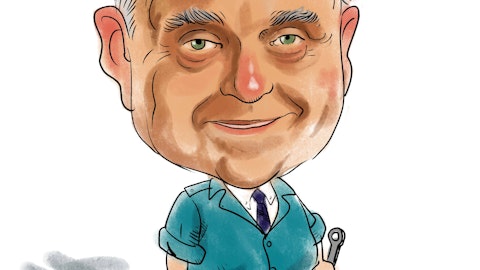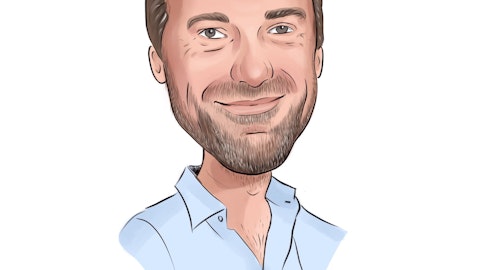Greg Brown: The Red Sea, we remain primarily on air as our mode of transportation. And so as a result, not a lot on the ocean and the impact of higher container rates is negligible for us. So given the state of the supply chain, while it’s improving, we found that air and air rates are a good investment to make. And make sure that we’re getting everything we need when we need it. We’ve seen continued improvement from supply chain and our vendors, particularly in some semiconductors. And they have some improvements to make and we expect them to continue to improve on the deliveries of — in particular, nanometer chips of 40 nanometers and above in some cases. So improving and working through it.
Jason Winkler: And as we worked through the year, it would be our expectation at the end of the year to have overall inventory reduced. Again, this year, as things normalize and improve.
Matthew Niknam: That’s relative to the $827 million you ended last year at?
Greg Brown: That’s right. The $827 million was down $200 million from its 12 month predecessor and we expect to drive $827 million down even further by year’s end as we navigate an improving environment.
Matthew Niknam: Appreciate it. Thank you.
Jason Winkler: Thank you.
Operator: The next question comes from the line of Adam Tindle with Raymond James. Your line is now open.
Adam Tindle: Okay. Thanks. Good afternoon. Jason, I just wanted to start on backlog trends for a clarification. I know reported backlog in total appears, the headline appears to be down, but I think there’s a lot of impact from Airwave in that. Could you just give us a sense of what backlog looks like ex-Airwave. And then just as a follow-up on that topic, either Jack or Greg or if you want both weigh in, this is just a metric that I think investors are watching very closely because backlog builds and records have happened across tech hardware, whether it’s Cisco in networking or [PCEs] (ph) before that and led to a sharper digestion period than initially anticipated once that backlog started softening. So wondering if you could maybe just double click on the current state of supply and demand and address how you think about the similarities or differences in what you’re seeing in your business and the time and shape of normalization, if and when that does happen.
Thank you.
Jason Winkler: Yeah, I would start out and tell you that this is one of the things I’m most proud of when I look at trend for the full year. Overall backlog of $14.3 billion, ending year from a year ago with absorbing just under $800 million decrement for the calculation of Airwave and the three year plus or three year backlog that that sits. So we’ll be able to keep that at the same level or comparable levels with that reduction is pretty significant. The other thing that gives me optimism is the exceptionally strong product backlog that we exited Q4 and the age backlog that we sit in the position of as we enter, but I also remind you, so I love the backlog position, but I also love the pipeline and the ongoing demand and what I see in the funnel and when I look at Molloy and his team’s conversion rates, I’m optimistic by what’s in backlog, I’m also optimistic what’s in pipeline.
Jack Molloy: Couple of attributes I think that are important to understanding our backlog. First, over 95% of our backlog comes to us from our government customers and our public safety customers. So, and the majority of that is a direct relationship and a contractual one between us and an end customer. That is very important. And secondly, as you think about our backlog, we entered the year much like last year in a position where about half of our revenues for the year, a little bit more than that will come to us from backlog. And with that strength combined with the pipeline strength, that’s what informs our guide for our 6% growth.
Jason Winkler: Exactly.
Adam Tindle: Very helpful. Just quickly, Jason, I’m sorry if I missed it, did you talk about free cash flow expectations in 2024 and any benefit from working capital with the Jabil agreement? I know sometimes that can have some transitional working capital that may be favorable. So free cash flow and the potential benefit.
Jason Winkler: Yeah, given that ’24 is an [operate in place] (ph) kind of steady agreement, the working capital benefits are minimal in terms of that agreement. That said, we do expect working capital improvement. We talked about inventory. Our outlook for operating cash flow was $2.2 billion, that’s up off of last year’s record $2 billion. And within that operating cash flow, the contribution for our CapEx continues to be 15% or less. So we are expecting another strong year of cash flow.
Adam Tindle: Very helpful. Thank you.
Operator: The next question comes from the line of Joseph Cardoso with J.P. Morgan. Your line is now open.
Joseph Cardoso: Hey. Thanks for the question, guys. I just wanted to follow-up on the last free cash flow question. I guess when I’m taking a look at it, it kind of implies that you’re going to have a nice step-up in free cash flow generation, which in combination, exiting 2023 with I think, $1.7 billion of cash on the balance sheet. Looks like you’ll have a fair bit of dry powder. Can you just help us think about the appetite in ’24 to deploy cash, buybacks, M&A? Like should we be thinking about a more aggressive than typical nature? Any color would be appreciated. Thank you.
Greg Brown: Just in terms of capital allocation, we always think of it. And I love the fact that we have the balance sheet that we do. Jason, in his remarks talked about 1.4 net-debt to adjusted EBITDA. So I love the opportunity — the flexibility that that gives us. I’m proud of the way we are good stewards of capital, both returning it to the shareholder and share repo and dividend, but being surgical and thoughtful to accretive acquisitions as well. So you think about this cash flow and I always think the wheel of 55-30-15. 55% of that cash flow is available for share repo or acquisition, fungible between the two, representative of the opportunities that come our way. 30% is dividend and 15% as Jason just referenced is CapEx. Even though we made only one acquisition at the end of the year in IP video, it certainly wasn’t reflective of the engagements that we had.
I think there’s a lot of opportunity. I love the fact that we have the organic opportunity, whether it’s device refresh, public safety prioritization, ARPA funding, enterprise opportunity, video and government, you know the opportunities that are in front of us organically, which are consequential. Equally, I’m excited about acquisition opportunities that can make our portfolio stronger, particularly around either video, software or services. So that’s how we think about it.
Jason Winkler: The other thing that was noteworthy in ’23 given the strength of our balance sheet is that we did earn an upgrade from Moody’s to be Aa2. And as Greg mentioned, we will be in the debt markets this year refinancing $1.3 billion. And so, having taken note of that strength of the cash flow in ’23 as well as our expectations in ’24, that will help us as we refinance.
Joseph Cardoso: Yeah. Guys, we appreciate the color there. And then just for my follow-up, can we just get an update on Airwave? I noticed in the press release, it sounded like you guys have the option to file an application with the UK Court of Appeal. Like are you guys actually taking that step? Can you provide any color around that? And then any color in terms of the next steps beyond the filing. And what other options you have at your disposal? Thanks for the question.
Greg Brown: Yeah, we will pursue the next step, which is appealing to the UK Court of Appeals. We anticipate doing that next week. I’ve said all along and we remain pretty consistent that this whole thing has — is beyond unique. We still believe it’s unprecedented. We think it’s legally flawed. But I’m not going to whine about it. I’m consistent in our description. We’re going to pursue all the avenues available to us to defend our position. So to your point, that will be the filing of the appeal to the UK Court of Appeals next week. Unclear how long that will take. Probably, several months, but that remains to be seen. The only other thing I’d say is in public commentary that has been made with the CMA and other parliamentary hearings, it’s pretty obvious that they believe that Airwave will be needed well beyond 2026.
The references have been made by different parties to either meeting it through 2029 or 2030. So we will continue to move forward as best we can, engaging where we can, maintaining the investments that we need to make in this network and customer service levels as high as they’ve ever been.
Jason Winkler: And just as a reminder, our current backlog with the adjustment we mentioned in Q4 has our contract with the UK Home Office through 2026.
Greg Brown: That’s right.
Jason Winkler: There’s opportunity for us to serve that account beyond that.
Joseph Cardoso: I appreciate the color, guys. Thanks. Thanks for all the questions.





